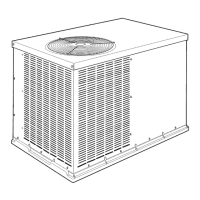Maintenance and Care for the Equipment Owner
Before proceeding with those things you might want to maintain
yourself, please carefully consider the following:
FIRE, EXPLOSION, ELECTRICAL SHOCK AND
CUT HAZARD
Failure to follow this warning could result in personal
injury, death or property damage.
1. TURN OFF ELECTRICAL POWER TO YOUR UNIT
BEFORE SERVICING OR PERFORMING
MAINTENANCE.
2. When removing access panels or performing
maintenance functions inside your unit, be aware of
sharp sheet metal parts and screws. Although special care
is taken to reduce sharp edges to a minimum, be
extremely careful when handling parts or reaching into
the unit. Wear safety glasses, gloves and appropriate
protective clothing.
Air Filters
The air filter(s) should be checked every 3 or 4 weeks and
changed or cleaned whenever it becomes dirty. Dirty filters
produce excessive stress on the blower motor and can cause the
motor to overheat and shut down.
This unit must have air filters in place before it can be operated.
These filters can be located in one of at least two places. In many
applications, the installer will provide return air filter grilles
mounted on the wall or ceiling of the conditioned structure. In the
instance of filter grilles, the filters can simply be removed from the
grille and replaced.
Table 1 indicates the correct indoor filter size for your unit.
Table 1 - Indoor Air Filter Data
Unit Size Filter Size
024 20x20x1 (508x508x25 mm)
030 20x24x1 (508x610x25 mm)
066-042 24x60x1 (610x762x25 mm)
048-060 24x66x1 (610x914x25 mm)
If you have difficulty locating your air filter(s) or have questions
concerning proper filter maintenance, contact your dealer for
instructions. When replacing filters, always use the same size and
type of filter that was supplied, originally, by the installer.
[]NIT OPERATION HAZARD
Failure to follow this caution may result in property
damage.
Never operate your unit without filters in place. An
accumulation of dust and lint on internal parts of your unit
can cause loss of efficiency and blower motor and/or
compressor damage.
Fans and Fan Motors
Periodically check the condition of fan wheels and housings and
fan-motor shaft bearings. No lubrication of condenser-or
evaporator-fan bearings or motors is required or recommended.
Indoor and Outdoor Coils
Cleaning of the coils should only be done by qualified service
personnel. Contact your dealer for the required annual
maintenance.
Condensate Drain
The drain pan and condensate drain line should be checked and
cleaned at the same time the cooling coils are checked by your
dealer.
Compressor
All compressors are hermetically sealed and do not require periodic
maintenance.
Condenser Fan
PERSONAL INJURY AND []NIT DAMAGE
HAZARD
Failure to follow this warning could result in personal
iniury, death or property damage.
Do not insert sticks, screwdrivers, or any other object into
revolving fan blades.
The fan must be kept free of all obstructions to ensure proper
cooling. Contact your dealer for any required service.
Electrical Controls and Wiring
Electrical controls are difficult to check without proper
instrumentation. If there are any discrepancies in the operating
cycle, contact your local dealer and request service.
Refrigerant Circuit
The refrigerant circuit is difficult to check for leaks without the
proper equipment. If inadequate cooling is suspected, contact your
local dealer for service.
EXPLOSION, BURN AND ENVIRONMENTAL
HAZARD
Failure to follow this warning could result in personal
iniury, death or property damage.
System under pressure. Relieve pressure and recover all
refrigerant before system repair or final unit disposal. Use
all service ports and open all flow-control devices,
including solenoid valves.
Unit Panels
After performing any maintenance or service on the unit, be sure
all panels are fastened securely in place to prevent rain from
entering unit cabinet and to prevent disruption of the correct unit
airflow pattern.
REGULAR DEALER MAINTENANCE
In addition to the type of routine maintenance you might be willing
to perform, your unit should be inspected regularly by a properly
trained service technician. An inspection (preferably each year, but
at least every other year) should include the following:
1. Inspection and, if required, cleaning of the indoor coil
condensate drain.
2. Inspection and, if required, cleaning of the evaporator drain
pan.
3. Inspection and cleaning of blower wheel housing and
motor.
4. Inspection of all supply-air and return-air ducts for leaks,
obstructions, and insulation integrity. Any problems found
should be resolved at this time.
5. Inspection of the unit base to ensure that no cracks, gaps,
etc., exist which may cause a hazardous condition.

